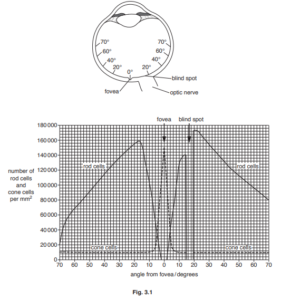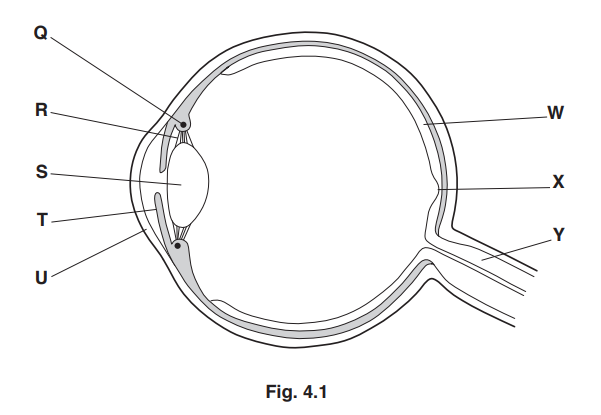Colour blindness in humans is caused by a fault in some of the light receptor cells in the retina of the eye. Rod cells and cone cells are two types of light receptor.
Question
(a) Complete Table 3.1 to state the function of three types of cell in the eye.
Table 3.1
| type of cell in the eye | function |
| rod cells | ……………………………………………………………………………… ……………………………………………………………………………… |
| cone cells | ……………………………………………………………………………… ……………………………………………………………………………… |
| sensory neurones | ……………………………………………………………………………… ……………………………………………………………………………… |
[3]
Answer/Explanation
Ans:
| part of the eye | function |
| rod cells | night vision /detects low light ; |
| cone cells | colour vision ; |
| sensory neurone | transmits nerve impulses to brain ; |
Question
(b) The number of rod cells and cone cells at places across the retina were recorded.
The diagram of an eye in Fig. 3.1 shows the angles from the fovea where the recordings were
made.
The graph in Fig. 3.1 shows the number of rod cells and cone cells across the retina.
Use Fig. 3.1 to describe and explain the distribution of rod cells and cone cells across the
retina.
…………………………………………………………………………………………………………………………………
…………………………………………………………………………………………………………………………………
…………………………………………………………………………………………………………………………………
…………………………………………………………………………………………………………………………………
…………………………………………………………………………………………………………………………………
…………………………………………………………………………………………………………………………………
…………………………………………………………………………………………………………………………………
…………………………………………………………………………………………………………………………………
…………………………………………………………………………………………………………………………………
…………………………………………………………………………………………………………………………………
………………………………………………………………………………………………………………………………..
[5]
Answer/Explanation
Ans:
1 more rod cells than cone cells in the retina ;
2 ref to uneven distribution of rod cells either side of fovea ;
3 no rod cells and no cone cells at blind spot ;
4 optic nerve enters /leaves retina at blind spot ;
5 only cone cells at the fovea / no rod cells at the fovea ;
6 maximum number of cone cells are at the, fovea / 0 degrees ;
7 maximum number of rod cells at 20–21 degrees ;
8 data quote include units ;
9 AVP ;
10 AVP ;

Question
(c) Colour blindness is a sex-linked characteristic.
The gene for colour vision is on the X chromosome.
There are two alleles of this gene:
• B is the allele for normal colour vision
• b is the allele for colour blindness.
Fig. 3.2 is a pedigree chart showing the inheritance of colour blindness in a family. The key
shows the sex chromosomes and the alleles of the gene for colour vision.

Describe evidence from Fig. 3.2 that shows that colour blindness is a sex-linked characteristic.
…………………………………………………………………………………………………………………………………
…………………………………………………………………………………………………………………………………
…………………………………………………………………………………………………………………………………
…………………………………………………………………………………………………………………………………
…………………………………………………………………………………………………………………………………
[2]
Answer/Explanation
Ans:
more males affected than females /ora ;
only females are carriers / males are affected or not ;
Question
(d) A man with normal colour vision (XBY) and a woman who is colour-blind (XbXb) have a baby.
Complete the genetic diagram to predict the probability that the baby is colour-blind.
parental phenotypes male with normal x colour-blind female
colour vision
parental genotypes XBY x XbXb
parental gametes 
offspring genotypes ………………. ………………. ………………. ……………….
offspring phenotypes ………………. ………………. ………………. ……………….
probability that the baby is colour-blind:
……………………………………………………………………………………………………………………………………………………….
[4]
Answer/Explanation
Ans:
| correct gametes ; correct offspring genotypes ; correct offspring phenotypes ; correct percentage ; | XB,Y +Xb, Xb ; |
Question
The eye is a sense organ that responds to light.
Fig. 4.1 is a diagram of a section through the human eye.

(a) Table 4.1 describes some of the functions of the parts of the eye.
Complete the table by:
• naming the parts of the eye
• using the letters on Fig. 4.1 to identify the parts of the eye.

[5]
(b) (i) A pair of muscles in the eye work in opposition to each other to adjust the amount of light
entering the pupil.
State the term that describes the action of a pair of muscles working in opposition to
each other.
………………………………………………………………………………………………………………………[1]
(ii) A different pair of muscles in the eye work in opposition to each other to view objects at
different distances from the eye.
State the name of the process that allows the eye to view objects at different distances.
………………………………………………………………………………………………………………………[1]
(c) Explain why the eye cannot easily identify different colours in low levels of light.
…………………………………………………………………………………………………………………………………
…………………………………………………………………………………………………………………………………
…………………………………………………………………………………………………………………………………
…………………………………………………………………………………………………………………………………
……………………………………………………………………………………………………………………………..[2]
(d) Some people inherit colour blindness and cannot identify certain colours, even in bright light.
The gene responsible for colour vision is located on the X chromosome.
There are two alleles for this gene on the X chromosome:
• XB – normal colour vision
• Xb – colour blindness.
(i) People that are heterozygous for colour blindness are called carriers.
State the genotype of a heterozygous female carrier.
………………………………………………………………………………………………………………………[1]
(ii) There is no gene for colour vision on the male sex chromosome.
State the genotype of a colour-blind male.
………………………………………………………………………………………………………………………[1]

(iii) Person 13 in Fig. 4.2 is male. His parents are person 7 and person 8.
Use the key to complete Fig. 4.2 by drawing the correct symbol for person 13. [1]
(iv) Colour blindness is a sex-linked characteristic.
Explain why females 4 and 5 are carriers even though their mother is not a carrier.
………………………………………………………………………………………………………………………….
………………………………………………………………………………………………………………………….
………………………………………………………………………………………………………………………….
………………………………………………………………………………………………………………………….
………………………………………………………………………………………………………………………[2]
Answer/Explanation
Ans:


Question
(a) The skin is important in helping to maintain a constant body temperature.
Fig. 5.1 shows a section through human skin.

(b) When a student has been running, the body temperature usually rises above normal.
Explain how sweating and vasodilation help to lower the body temperature.

(c) Suggest one function of the skin, other than the control of body temperature.

Answer/Explanation
Ans:


Question
Fig. 2.1 shows a section through the eye of a small mammal as viewed with a microscope.

(a) Name the structures labelled X, Y and Z.

(b) A student looks at a clock at the far end of an examination room and then looks at a
diagram on her examination paper.
Describe the changes that take place in her eyes so that she can focus on the diagram.

(c) The shortest distance from the eye at which a clear focus is possible is known as the
near point. As a person gets older this distance changes.
Table 2.1 shows the near point for people of different ages who have normal vision.


(i) Plot the data in Table 2.1 on the grid. [4]
(ii) Use the graph to estimate the distance of the near point for a 30 year old person.
![]()
(iii) Use the graph to estimate the age of a person whose near point is 32.0 cm.
![]()
Answer/Explanation
Ans:

